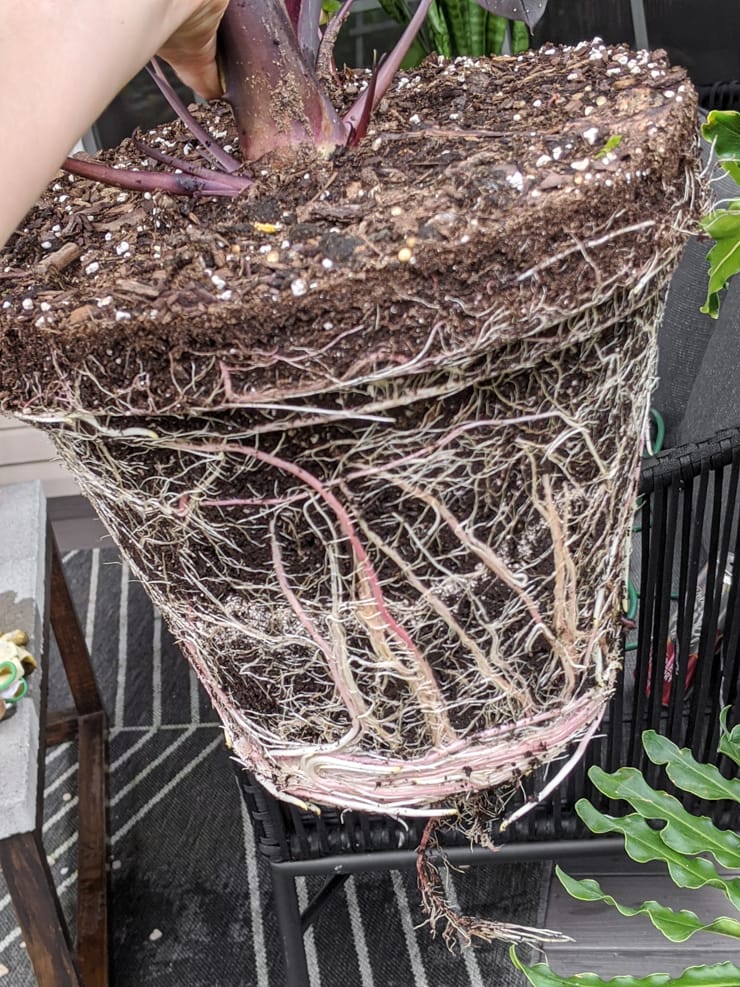How to grow gorgeous alocasia odora
Alocasia odora is probably the first elephant ear plant I ever grew. It’s definitely a “gateway” elephant ear plant because it’s so easy to find in garden centers in nurseries. You’ll often find it either as a potted patio plant or a corm (similar to a bulb).
Odora is often referred to as an “upright elephant ear” or a “giant” elephant ear. Oftentimes people refer to alocasia odora plants as just “elephant ears.” This plant can get quite large with leaves shaped like blades, arrowheads, or—you guessed it—elephant ears.

Light
Alocasia odora can take full sun. It also does well in partial shade and even full shade outdoors. I usually have mine growing in full sun in the ground. If you have your plant in a pot and are bringing it home from a garden center, take note of the conditions it was in. If they had it in full sun outdoors, you can put yours in full sun.
However, if they had it inside a greenhouse or under a shade cloth, I would recommend slowly acclimating the plant to direct sun. Give it more light every few days so it can build up its tolerance—you don’t want to burn the foliage!

Soil
If you’re planting your alocasia odora in the ground as I do, here’s what I did. We have very rocky, dense, clay soil. So I dug out a hole about 3 times or so bigger than the big bulb/corm I brought home.
I then mixed in some leaf compost from a bag I got at Lowes with some of the native soil. This helps to loosen things up, add nutrients, and improve drainage. I put a layer in, add the bulb, and then fill in around it with more of the mixture. Make sure the tip of the bulb stays out of the soil a bit.
In pots, you can use any type of soil that is designed for houseplants, container gardens, or indoor plants. These come pre-mixed with things like bark or perlite to improve drainage.

Water
I almost never water the alocasia odora if it is planted in the ground. I let mother nature take care of things. However, in Maryland we experienced periods of drought. When we have a week or so without rain, I will give the plant a drink. It’s pretty tolerant of neglect when in the ground.
If you have the plant in a container as I also do on my patio, it’s a different story. Containers need lots of water because the sun and heat totally zaps the moisture from them. I also have mine planted with a sweet potato vine, so there isn’t a lot of room in there. I water this one daily.


Humidity
Alocasia plants in general enjoy higher humidity. Above 50% for sure, which is usually not a problem in the spring, summer, and early fall where I live. It is generally tolerant of lower humidity levels, though—so don’t avoid trying it out in your garden if you don’t live somewhere super humid.
Temperature
Alocasia odora will grow happily in warm temperatures. You can grow it yearround outdoors if you live in USDA zones 9, 10, and 11. Keep in mind, though, that colder temps in these grow zones might kill off the foliage. The plant will resprout, though, because it shouldn’t get cold enough to nuke the bulbs/corms.
The plant will be fine outdoors when night temperatures begin dropping into the 50s Fahrenheit, but it isn’t ideal. Shoot for temperatures in the 60s, 70s, 80s, and even 90s.
This plant is not cold or frost hardy at all, so make sure to drag potted odora plants indoors when temperatures begin to drop. Or, if you have it in the ground, dig up the bulbs/corms and store them indoors until spring.

Growth
Alocasia odora can grow to be 4 to 6 feet tall and wide. To achieve this, I recommend planting them in the ground so they have enough room to spread out and reach their fullest potential. At the end of the growing season last year, my largest leaf was 26 inches tall and 18 inches wide.
In good conditions with consistently warm temperatures, upright elephant ear plants grow quite prolifically.
Our growing season got off to a rough start last year. My bulb sat in the ground for weeks before doing anything. I actually thought that maybe it had rotted, but I didn’t dig it up. Finally it sprouted a small leaf. And after that it was off to the races! It put out new leaves constantly as long as I kept it watered during periods with no rain.
You can help encourage healthy new growth by periodically fertilizing your plant. If you’ve just potted the plant up, remember that the soil you use probably has some sort of slow-release fertilizer in it, so don’t over-fertilize.


Repotting
I do not tend to repot my Alocasia odora plants. I either have them planted in the ground, or I keep them in a pot all summer and dig them up to store in the fall. For elephant ear plants in general, I tend to wait until my plant is super rootbound (roots growing around the bottom of the pot in circles) or the roots are growing out of the pots drainage holes before repotting.
Keep in mind that elephant ears multiply, too. They spread under the soil through runners that produce new offshoot baby plants. When you dig them up, you can easily separate the baby/pup plants from the mother plant and plant them separately. So they basically propagate themselves!


Pruning
I’m a big fan of cutting off the older elephant leaves as they either die off or just look unsightly. Don’t be worried if you have to do some pruning throughout the season. It’s very normal. I find that pruning off the older, smaller leaves really helps the plant focus its energy on new growth. And the leaves get bigger and bigger each time!
Toxicity
Alocasia plants contain calcium oxalates. According to the ASPCA, ingesting the plant can cause oral irritation; pain and swelling of mouth, tongue and lips; excessive drooling; vomiting; and difficulty swallowing.
Humans and animals should not ingest this plant. So make sure you keep these plants away from pets who might be interested in eating them. Keep an eye on your kids, too.
Pin my guide!


Brittany is a seasoned DIY home and garden expert, running a creative brand since 2014 that inspires others with approachable plant care guides, woodworking tutorials, and decor projects. She is a certified project manager and has completed extensive coursework in the art and science of growing your own plants. Her work has been recognized by major publications, and she routinely collaborates with fellow DIY industry leaders—but her favorite thing to do is inspire you! Learn more about her here.

Leave a comment